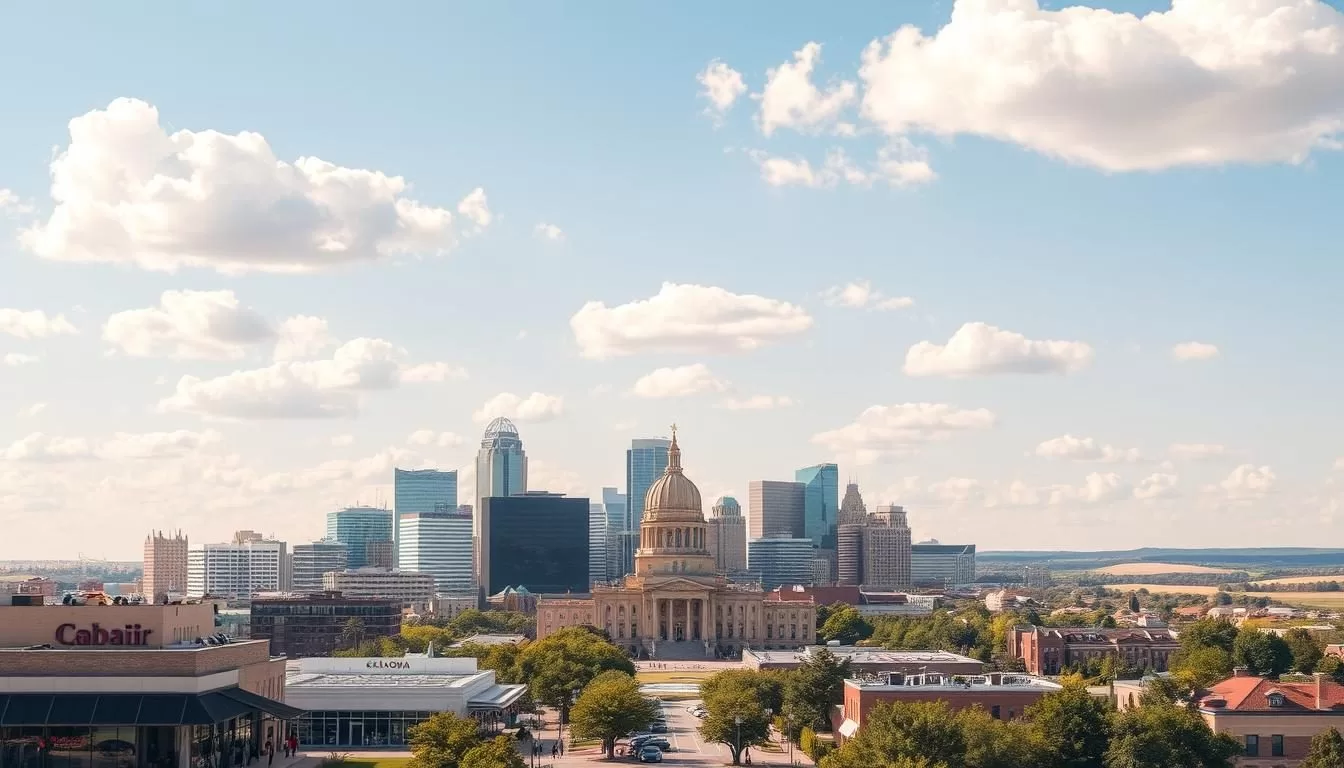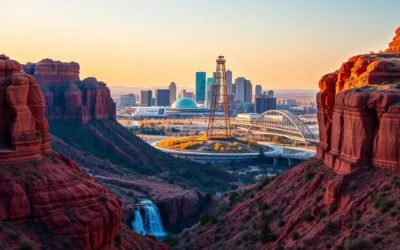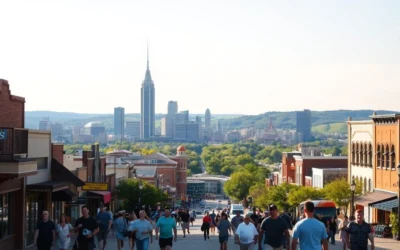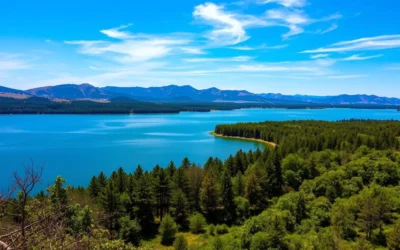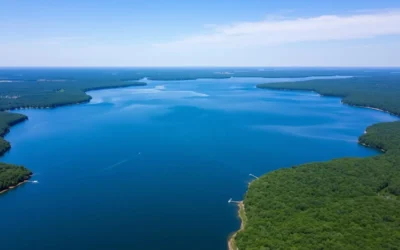Are you ready to explore Oklahoma City and experience all it has to offer? Understanding the local weather and season is crucial for a successful trip.
Oklahoma’s climate varies significantly throughout the year, with each season presenting unique opportunities for exploration and enjoyment. From vibrant summer festivals to colorful fall foliage, and from mild winter celebrations to blooming spring landscapes, the state’s diverse experiences are shaped by its temperatures and weather conditions.
To make the most of your visit, it’s essential to determine the ideal months to visit based on your preferred activities and comfort level. This guide will help you plan a trip that aligns with your interests and preferences, ensuring a memorable experience in Oklahoma City.
Understanding Oklahoma’s Climate
The climate in Oklahoma City is characterized by its humid subtropical classification, offering a blend of hot summers and mild winters. This classification indicates that Oklahoma City experiences a wide range of weather conditions throughout the year.
Four Distinct Seasons
Oklahoma experiences four distinct seasons throughout the year, each offering unique weather patterns and experiences for visitors to enjoy. The transition between these seasons can be quite dramatic, with significant changes in temperature and precipitation.
Humid Subtropical Climate Characteristics
The state’s climate is classified as humid subtropical, characterized by hot, humid summers and relatively mild winters compared to northern states like North Dakota and South Dakota. Summer temperatures in Oklahoma City typically range from the 80s to 90s Fahrenheit (27-34°C), with high humidity levels making it feel even warmer.
Temperature and Precipitation Patterns
Weather patterns in Oklahoma City vary significantly throughout the year. July records the hottest temperatures, while January sees the coldest. Precipitation patterns also vary, with June being the wettest month (2.68 inches) and January the driest (1.25 inches).
| Month | Average Temperature (°F) | Precipitation (inches) |
|---|---|---|
| January | 39 | 1.25 |
| June | 82 | 2.68 |
| July | 89 | 2.34 |
Understanding these climate characteristics will help you pack appropriately and plan activities that align with the weather conditions during your visit to Oklahoma City.
Summer in Oklahoma: Hot and Vibrant
When summer arrives in Oklahoma City, the heat is on, but so are the events and activities. The city’s summer season is characterized by hot and humid conditions, but it remains a popular time for family vacations due to the numerous water-based activities and vibrant cultural events.
Temperature and Weather Conditions
Summer in Oklahoma City brings hot and humid conditions, with temperatures typically ranging from 88°F to 94°F (31-34°C) between June and August. This makes it considerably warmer than summer in cities like New York or Puerto Rico. Despite the heat, the summer season is a great time to enjoy the city’s outdoor recreational activities.
Popular Summer Events and Festivals
Oklahoma City hosts a variety of events and festivals during the summer. The 4th of July fireworks displays are a highlight, along with the OKC Pride festival and the deadCENTER Film Festival. These events provide a fun way to experience the city’s culture and community.

Outdoor Activities to Beat the Heat
To beat the heat, you can enjoy paddling on the Oklahoma River through the Boathouse District, or cool down at water parks like Hurricane Harbor and Frontier City’s Wild West Water Works. Families with children can also enjoy the “sprayground” at Scissortail Park, an interactive water feature perfect for hot summer days.
Packing Tips for Summer Visitors
When packing for a summer trip to Oklahoma City, it’s essential to include lightweight, breathable clothing and sun protection such as hats, sunglasses, and sunscreen. Planning your outdoor activities for early mornings and evenings can also help you avoid the peak heat.
Fall in Oklahoma: Comfortable and Colorful
The fall season in Oklahoma City brings a welcome change from the summer heat, with mild temperatures and festive events. As the summer swelter subsides, the temperatures drop to a comfortable range of 60 to 80 degrees F (16 to 27 C), making it an ideal time for outdoor activities and exploration.
Temperature and Weather Patterns
During the fall season, Oklahoma City experiences a gradual cooling of temperatures, creating a comfortable climate for visitors. The average temperature range between September and November is between 60-80°F (16-27°C), making it perfect for outdoor exploration and enjoying the city’s many attractions.
Key weather characteristics during fall in Oklahoma City include:
- Mild daytime temperatures
- Cooler nights
- Reduced humidity
- Generally dry conditions, although occasional rain showers can occur
Fall Foliage and Scenic Drives
Oklahoma’s autumn landscape is transformed with vibrant foliage displays, particularly in the eastern parts of the state. The Ouachita Mountains and the Talimena Scenic Byway offer breathtaking views of the autumn colors, making them popular destinations for scenic drives.
Harvest Festivals and Seasonal Events
Fall in Oklahoma City is marked by numerous harvest festivals and seasonal events. Some of the notable events include:
- The Oklahoma State Fair
- The Red Earth American Indian Festival
- Frontier City’s annual Hallowfest
- Pumpkin patches and corn mazes at the Myriad Botanical Gardens and surrounding farms
These events offer a range of activities for visitors, from family-friendly outings to culturally rich experiences.
What to Pack for an Autumn Trip
When planning your trip to Oklahoma City during the fall, it’s essential to pack layered clothing, as temperatures can vary significantly between morning, afternoon, and evening hours. Comfortable shoes for walking and outdoor activities are also recommended.
With its comfortable temperatures, reduced humidity, and wealth of seasonal activities, fall represents one of the most pleasant seasons for a weather-savvy trip to Oklahoma City. Whether you’re interested in outdoor exploration, cultural events, or simply enjoying the fall foliage, Oklahoma City has something to offer.
Winter in Oklahoma: Mild and Festive
When winter arrives in Oklahoma City, you can expect a festive atmosphere with mild temperatures, perfect for enjoying the city’s events and attractions. The winter season brings a unique charm to the city, with holiday celebrations and decorations transforming the downtown area.
Temperature Ranges and Precipitation
Winter in Oklahoma City is relatively mild, with average temperatures ranging from 28°F to 54°F (-2°C to 12°C) between December and February. Compared to states like West Virginia, Oklahoma City avoids heavy snows and icy conditions, making it easier to navigate during the winter months. The city’s snowfall is minimal, similar to some parts of New Mexico, ensuring that winter travel remains generally easy and accessible.
Holiday Celebrations and Winter Events
The city hosts various holiday events, including Downtown in December, which features outdoor ice skating, holiday markets, and beautiful light displays. These events create a warm and inviting atmosphere, despite the cooler temperatures.
- Enjoy outdoor ice skating and holiday markets during events like Downtown in December.
- Experience the festive decorations and light displays throughout the city.
- Take advantage of the drier conditions, with January being the driest month, averaging just 1.25 inches of precipitation.
Indoor Attractions for Colder Days
For days when the weather is too cold, Oklahoma City offers numerous indoor attractions, such as the Oklahoma City Museum of Art, Science Museum Oklahoma, and the National Cowboy and Western Heritage Museum.
Winter Packing Essentials
When planning your trip to Oklahoma City during winter, pack warm clothing, including long pants, sweaters, and a winter coat. Although the climate is relatively mild, temperatures can dip below freezing, especially at night.
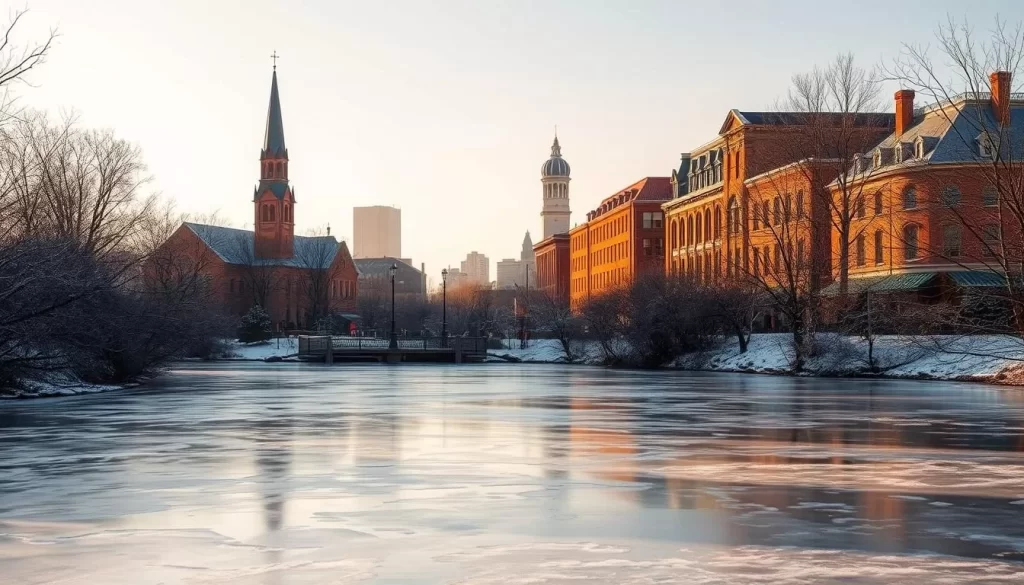
Spring in Oklahoma: Renewal and Bloom
With the arrival of spring, Oklahoma City comes alive with a mix of cultural events, outdoor activities, and pleasant weather. As the last wisps of winter dissipate, the city transforms into a vibrant hub of activity, making it an ideal time for a trip to this dynamic city.
Weather Transitions and Rainfall
Spring in Oklahoma City brings a refreshing transition from winter’s chill, with temperatures gradually warming from March’s average of 52°F (11°C) to May’s pleasant 69°F (21°C). This season is characterized by increasing rainfall, with May being the wettest month, bringing lush greenery and blooming wildflowers across Oklahoma’s landscapes.
Spring Festivals and Cultural Events
The city’s annual Festival of the Arts is a cultureal highlight, celebrating creativity through visual arts, performances, and culinary experiences. This event draws visitors downtown, showcasing the city’s rich culture and artistic expression.
Outdoor Recreation Opportunities
Spring break presents an excellent opportunity for family trips to Oklahoma City, with numerous family-friendly attractions and outdoor recreation options. The Adventure District offers concentrated entertainment, while the Boathouse District provides exciting outdoor activities along the Oklahoma River.
Spring Break Planning Tips
When planning your spring break trip, consider the risk of severe weather, particularly thunderstorms and tornadoes. Packing layered clothing and rain gear is essential to accommodate temperature fluctuations and increased precipitation. For a memorable experience, explore Oklahoma’s natural landscapes, which rival the spring beauty found in states like New Jersey.
Oklahoma, United States: Best Months for a Weather-Savvy Trip
For travelers to Oklahoma City, knowing the best months to visit can make a significant difference in their experience. The city’s weather varies throughout the year, with some months being more conducive to outdoor activities and comfortable travel.
April-May: Ideal Spring Conditions
Spring is a beautiful time in Oklahoma City, with mild temperatures and vibrant blooms. April and May are particularly ideal, with average temperatures ranging from 61°F to 69°F (16-21°C). This period is perfect for exploring outdoor attractions without the summer heat or humidity.
September-October: Perfect Fall Weather
Fall in Oklahoma City is another comfortable season, with September and October offering pleasant weather. The temperatures gradually cool down from the summer highs to a comfortable range of 62-74°F (17-23°C). This fall weather is similar to New Hampshire’s, but with less dramatic foliage.
Weather Considerations for Different Activities
When planning your trip, consider the optimal weather for your activities. For instance, wildlife viewing is excellent in spring, while water activities peak in summer. Hiking is most comfortable in fall, and indoor cultural attractions can be enjoyed year-round.
| Month | Average Temperature | Activity Suitability |
|---|---|---|
| April | 61-69°F | Wildlife viewing, outdoor exploration |
| May | 69°F | Outdoor festivals, spring blooms |
| September | 74°F | Hiking, fall foliage |
| October | 62-74°F | Fall activities, comfortable temperatures |
Choosing the right months for your trip to Oklahoma City ensures a more enjoyable experience. The shoulder seasons of spring and fall offer not only comfortable temperatures but also fewer crowds and potentially lower accommodation rates.
![]()
Severe Weather Awareness in Oklahoma
Oklahoma’s location in “Tornado Alley” makes it essential for visitors to understand and prepare for severe weather. When visiting Oklahoma City, being aware of the weather conditions can significantly impact the safety and enjoyment of your trip.
Tornado Season and Safety Precautions
The peak tornado season in Oklahoma runs from April through June. Unlike places such as American Samoa, Oklahoma experiences a unique weather pattern that includes tornadoes. Understanding the difference between a tornado watch and a tornado warning is crucial. A watch indicates conditions are favorable for tornadoes, while a warning signifies a tornado has been sighted or is imminent.
Thunderstorm Patterns
Thunderstorms in Oklahoma can develop rapidly and become severe, producing dangerous lightning, hail, strong winds, and flash flooding. Visitors, especially those exploring outdoor areas like the Wichita Mountains Wildlife Refuge during spring and early summer, should monitor weather alerts closely.
Emergency Preparedness for Visitors
To stay safe, identify safe shelter locations in advance, such as basements or interior rooms without windows on the lowest floor of buildings. Keeping cell phones charged and having a weather radio or app with alerts enabled are also crucial steps. Visitors should be prepared for possible power outages and know the severe weather plans of any attractions they visit.
| Safety Measure | Description |
|---|---|
| Identify Safe Shelters | Basements or interior rooms without windows |
| Stay Informed | Monitor weather alerts and warnings |
| Prepare for Emergencies | Keep cell phones charged, have a weather radio |
Oklahoma City: Urban Weather Experiences
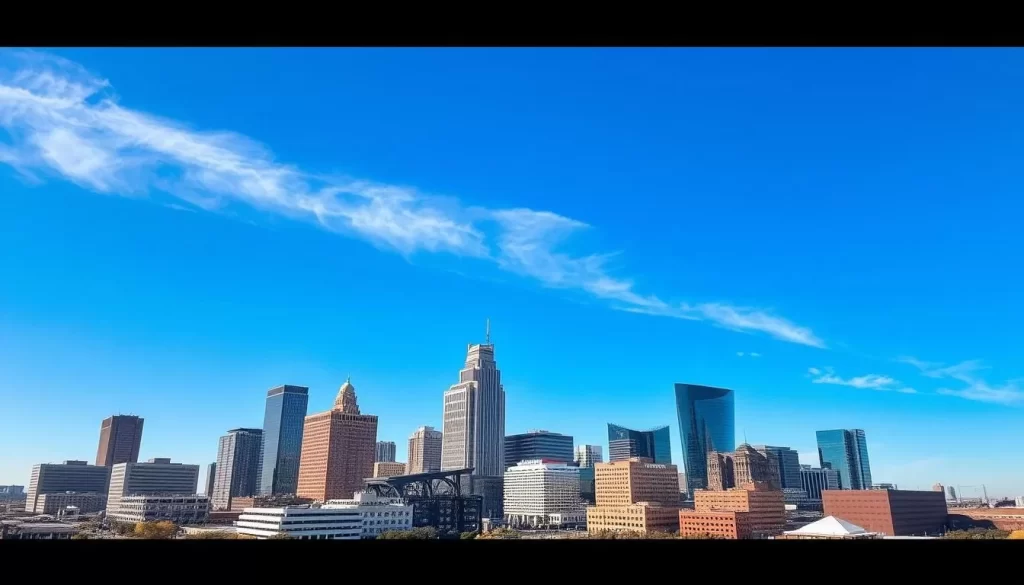
As you explore Oklahoma City, you’ll experience a climate shaped by its urban landscape. The city’s weather is characterized by hot, muggy summers and mild winters, with comfortable falls and moderate springs.
Microclimate Considerations
Oklahoma City’s urban environment creates unique microclimates that differ from surrounding rural areas. The city’s layout and building density contribute to these variations, with downtown areas typically experiencing less air movement and higher temperatures than parks and riverside locations.
The urban heat island effect is another significant factor, causing temperatures in the city center to be 2-5°F higher than in outlying areas. This effect is particularly noticeable during summer months when temperatures soar into the 80s and 90s Fahrenheit.
Urban Heat Island Effect
The urban heat island effect in Oklahoma City is pronounced due to its sprawling design, unlike more compact urban centers like those in New York or Rhode Island. This design allows for significant weather variations across different neighborhoods and districts.
To mitigate the urban heat island effect, Oklahoma City has incorporated numerous parks, including the Myriad Botanical Gardens and Scissortail Park, which offer cooler microclimates within the urban environment.
Best Weather Months for City Exploration
The best months to explore Oklahoma City’s urban attractions are typically April, May, September, and October. During these months, temperatures are moderate, making outdoor activities more comfortable.
When planning your visit, consider the time of day as well. Morning and evening hours are more comfortable during summer, while midday is pleasant during spring, fall, and winter.
Tulsa Weather Patterns and Best Visiting Times
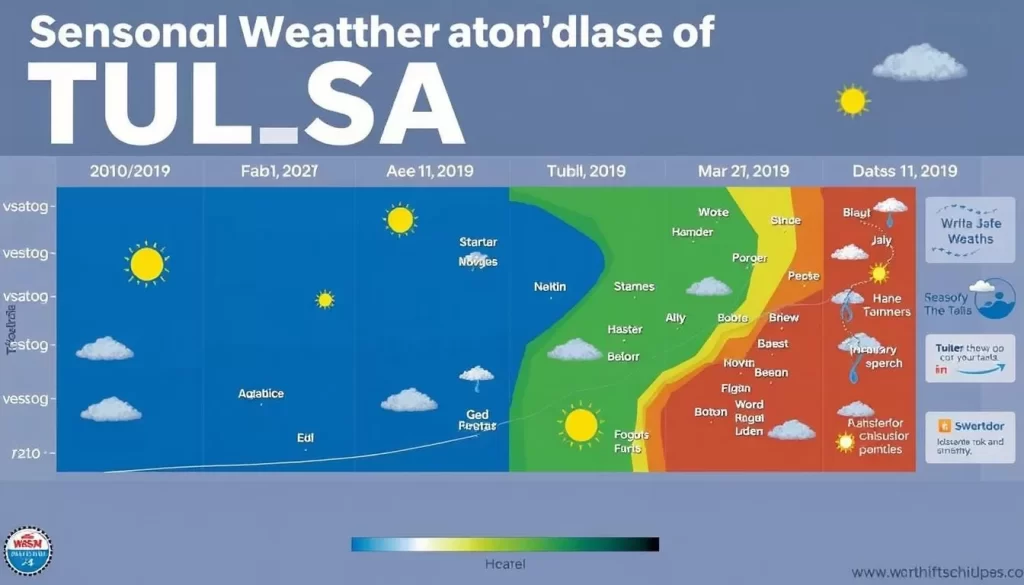
Tulsa, Oklahoma, experiences a humid continental climate, characterized by four distinct seasons. Understanding these seasonal variations is crucial for planning a visit that suits your preferences.
Climate Comparison with Oklahoma City
Tulsa’s climate differs slightly from Oklahoma City‘s, with generally higher precipitation and cooler temperatures due to its northeastern location. While both cities share the characteristic four seasons of the central United States, Tulsa’s climate is classified as humid continental, unlike Oklahoma City’s humid subtropical climate.
Seasonal Highlights
Summer in Tulsa is hot and humid, with temperatures ranging from 81°F to 95°F (27-35°C), similar to parts of New Mexico but with higher humidity. In contrast, fall is one of the best seasons to visit, with comfortable temperatures and vibrant foliage, especially in October.
Weather-Based Activity Recommendations
For a trip to Tulsa, consider exploring outdoor attractions like Turkey Mountain Urban Wilderness during spring and fall, enjoying water activities during summer, or experiencing the city’s indoor cultural attractions during winter. The best times to visit for pleasant weather are April-May and September-October.
By understanding Tulsa’s weather patterns, you can plan your activities and make the most of your visit to this cultural center in the United States.
Outdoor Recreation Based on Weather Conditions
From the scenic trails of Tulsa to the lakes and rivers across Oklahoma, the state’s outdoor recreation opportunities are significantly shaped by seasonal weather patterns. As you plan your trip to Oklahoma City or explore other parts of the state, understanding how the weather impacts these activities can greatly enhance your experience.
Water Activities at Lakes and Rivers
Oklahoma’s lakes and rivers offer a variety of water activities that peak during the summer months when temperatures soar. Lakes like Lake Hefner, Lake Thunderbird, and Arcadia Lake become popular spots for boating, fishing, and swimming. The Illinois River in eastern Oklahoma is particularly renowned for kayaking and canoeing, with late spring and early fall providing the most pleasant conditions.
| Activity | Best Season | Popular Locations |
|---|---|---|
| Boating | Summer | Lake Hefner, Lake Thunderbird |
| Kayaking/Canoeing | Late Spring, Early Fall | Illinois River |
| Swimming | Summer | Arcadia Lake |
Hiking and Nature Trails by Season
Hiking enthusiasts find the most comfortable conditions during spring and fall. Trails at the Wichita Mountains Wildlife Refuge, Chickasaw National Recreation Area, and Ouachita National Forest offer varying difficulty levels and spectacular seasonal views. Tulsa’s extensive park system, including the Mingo Trail System and Turkey Mountain Urban Wilderness, provides additional options for hikers and bikers.
Wildlife Viewing Opportunities
Wildlife viewing opportunities abound year-round but vary by season. Spring brings bird migrations and newborn animals, summer offers active reptile sightings, fall coincides with deer rutting season, and winter provides better visibility through leafless trees. The Wichita Mountains Wildlife Refuge is a prime location for observing wildlife in their natural habitats.
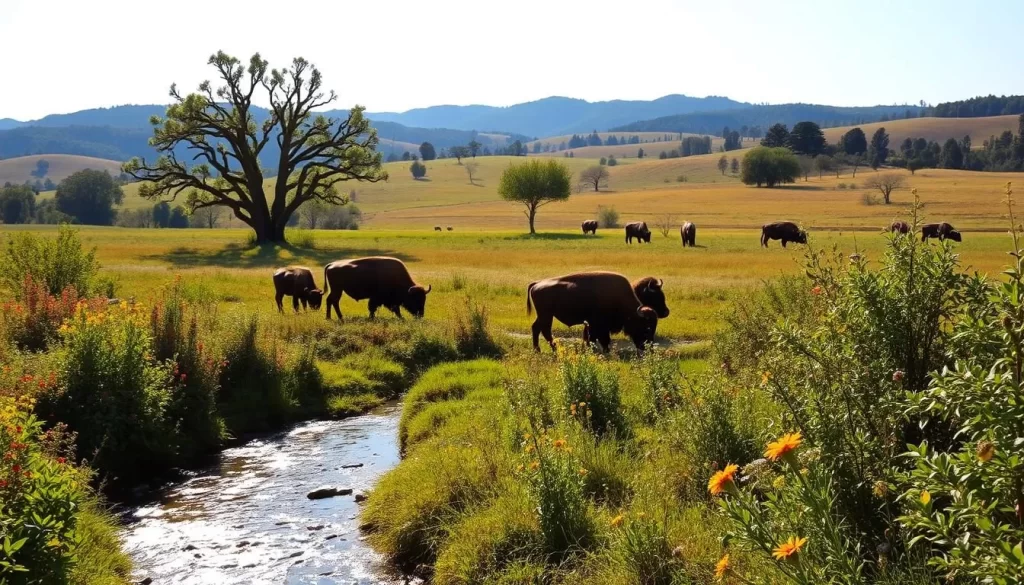
State Parks and Natural Attractions
Oklahoma’s 33 state parks experience different peak seasons based on their locations and features. Roman Nose State Park and Beavers Bend State Park are particularly beautiful during fall color changes, offering scenic drives, hiking trails, and other outdoor activities.
By considering the weather and seasonal variations, you can plan your outdoor adventures in Oklahoma to make the most of your trip, whether you’re exploring the urban landscapes of Oklahoma City or enjoying the natural beauty of the state’s parks and refuges.
Cultural Events Calendar and Weather Considerations
Oklahoma City’s cultural scene is a vibrant reflection of the state’s rich heritage and diverse influences. The city’s cultural events calendar is filled with festivals and celebrations throughout the year, each occurring during different weather conditions that visitors should consider when planning their trip.
Annual Festivals and Their Typical Weather
Spring brings the Festival of the Arts in April, typically experiencing mild temperatures around 72°F (22°C) with occasional spring showers. This creates a pleasant atmosphere for this premier cultural event that rivals similar festivals in New York and other major United States cities.
Summer festivals include the deadCENTER Film Festival in June and numerous Independence Day celebrations in July, which take place during hot and humid conditions, often with temperatures exceeding 90°F (32°C).
Indoor Cultural Attractions
For those seeking refuge from the weather, Oklahoma City offers several indoor cultural attractions. The National Cowboy & Western Heritage Museum, Oklahoma City Museum of Art, and First Americans Museum provide climate-controlled environments for cultural exploration regardless of outside weather conditions.
Native American Cultural Experiences
Oklahoma offers exceptional opportunities to experience the heritage of the 39 tribal nations headquartered in the state. Visitors can enjoy culture-rich experiences, including powwows and events that showcase Native American traditions.
When planning a culture-focused trip to Oklahoma City, consider that spring and fall offer the most comfortable outdoor festival weather, while summer events often incorporate water features or evening schedules to accommodate the heat.
Budget-Friendly Travel During Off-Peak Weather Seasons
Planning a trip to Oklahoma City can be more budget-friendly if you consider traveling during off-peak weather seasons. This approach not only saves you money but also provides a more authentic experience with fewer tourists.
Accommodation Deals by Season
Accommodation rates in Oklahoma City can drop by 20-30% during January and February compared to the summer peak season. This significant reduction in prices makes winter an attractive time for budget-conscious travelers.
Transportation Cost Variations
Transportation costs to Oklahoma City also fluctuate seasonally. Lower airfares are typically available during January, February, and early November when demand decreases, making these periods ideal for booking your trip.
Value Activities During Less Popular Weather Months
During the less popular weather months, you can enjoy various activities at discounted rates. These include:
- Discounted admission to museums and cultural attractions
- Special winter programming at the Oklahoma City Zoo
- Reduced rates for indoor entertainment venues
Here’s a comparison of average costs during peak and off-peak seasons:
| Season | Accommodation | Transportation | Attractions |
|---|---|---|---|
| Peak Season (Summer) | $150/night | $400/flight | $20/person |
| Off-Peak Season (Winter) | $100/night | $250/flight | $15/person |
By traveling during the off-peak season, you can enjoy a more budget-friendly trip to Oklahoma City while still experiencing the city’s attractions and culture.
Family-Friendly Weather Windows for Oklahoma Trips
When traveling with children, Oklahoma City offers several family-friendly weather windows that make for an ideal trip. The city’s climate varies significantly across different seasons, making some times more suitable for family vacations than others.
Best Times for Family Travel
The most child-friendly weather windows in Oklahoma City typically fall during late spring (May) and early fall (September-October), when temperatures are moderate and outdoor activities are comfortable. For instance, spring break in March or April offers pleasant weather, with average temperatures between 52-61°F (11-16°C), making it an attractive time for families.
Weather-Appropriate Family Activities
Weather-appropriate family activities vary by season. Summer calls for water parks and early morning zoo visits, while fall is perfect for outdoor adventures and festivals. In contrast, winter invites indoor museum exploration and holiday events, and spring welcomes playground time and nature activities.
| Season | Weather | Family Activities |
|---|---|---|
| Spring | Mild temperatures | Playground time, nature activities |
| Summer | Hot | Water parks, early morning zoo visits |
| Fall | Comfortable temperatures | Outdoor adventures, festivals |
| Winter | Cool to mild | Indoor museum exploration, holiday events |
Planning Around School Breaks and Weather
When planning your trip, consider that Oklahoma’s weather can be unpredictable during spring break season, requiring flexible itineraries. Family trips during winter holiday breaks can benefit from Oklahoma City’s festive atmosphere and relatively mild winter temperatures.
Photography and Sightseeing: Weather-Based Recommendations
The ever-changing weather in Oklahoma provides a dynamic backdrop for photographers and sightseers alike. As you plan your trip to Oklahoma City, understanding the best weather conditions can enhance your experience.
Best Light and Weather Conditions
Oklahoma’s diverse weather conditions offer unique lighting and atmospheric opportunities for capturing memorable images. The “golden hours” shortly after sunrise and before sunset provide the most flattering natural light for photography in Oklahoma City.
- The extended daylight hours in summer create warm, golden tones across urban and natural landscapes.
- Fall brings a diverse color palette, particularly in the eastern parts of the state, rivaling the autumn colors of North Carolina and South Carolina in October.
- Spring captures vibrant wildflowers and green landscapes, with April and May offering dramatic skies similar to those found in Illinois and Indiana.
Seasonal Landscape Photography Opportunities
Summer photography benefits from extended daylight hours, but harsh midday light can be challenging. Early morning shoots at locations like Myriad Botanical Gardens or Lake Hefner offer the best conditions.
Urban and Rural Photography Spots
Oklahoma City offers numerous photography spots, including the downtown skyline, Bricktown Canal area, and Scissortail Bridge. Rural areas like the Wichita Mountains Wildlife Refuge and Tallgrass Prairie Preserve provide diverse landscapes that transform with the seasons.
Conclusion
Oklahoma’s climate, characterized by distinct seasons, provides a rich backdrop for travelers to explore its vibrant culture and natural beauty. The state’s diverse weather patterns mean that each season offers unique experiences and activities, making it a versatile destination in the United States.
The best months to visit Oklahoma City are typically during the spring (April-May) and fall (September-October), when the weather is mild and conducive to outdoor exploration. Summer brings its own charm with vibrant festivals and water activities, although it’s also the hottest and most humid period. In contrast, fall is perhaps the most appealing season, with comfortable temperatures and picturesque foliage.
Winter offers a more budget-friendly option for travelers, with lower accommodation rates and fewer crowds, making it ideal for exploring indoor cultural attractions. Meanwhile, spring brings renewal, with wildflowers blooming across the state, though it’s also a time when severe weather can occur.
Whether you’re visiting from nearby states like West Virginia or New Jersey, or from further afield, understanding Oklahoma’s weather patterns will help you plan your trip effectively. Ultimately, the ideal time for your visit depends on your interests and what you want to experience, from summer adventures to fall landscapes, ensuring there’s a perfect season for every traveler.
By considering these factors, you can tailor your trip to Oklahoma City to make the most of your travel experience, enjoying the state’s culture, natural beauty, and seasonal activities to the fullest.
The above is subject to change.
Check back often to TRAVEL.COM for the latest travel tips and deals.
Here are some Tours & Sightseeing suggestions that might pique your interests!
